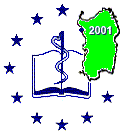 |
Why are medical
librarians coming to conferences - and why not?
Oliver Obst
|
|
|
Click here to see the poster in pdf format |
|
|
 |
Introduction
One of the astonishing things on European and international conferences of medical libarianship is the obvious imbalance between number of delegates and the population size of their respective country. On the first glance there seems to be no correlation between population and delegates - more people are coming from Switzerland than from Germany and more from Iceland than from Greece to EAHIL or ICML conferences. So it seems doubtful if the population influences the attendance figures. In the following it should be examinated which attributes of countries make it more likely that their medical librarians are coming to conferences and which prevent them from participating. Attributes
examined should be only hard statistical data such as gross domestic products,
health expenditure, educational quantities or population sizes. Differences
in mentality (like the ones HOBOHM stated) or individual reasons and intentions
will not be discussed.
Methods The number
of delegates of the four international EAHIL and ICML conferences in Oslo
(1994), Washington (1995), Coimbra (1996), and London (2000) were taken
from the respective official attendance lists. The national identity of
EAHIL members were taken from the membership list dated October 2000. The
population size and the gross domestic product (absolute: GDP, per capita:
GDPcap) were taken from the CIA World Factbook. The number of university
libraries, students, medical students, and the health expenditure per capita
(HEcap) were taken from the UNESCO Yearbook 1999. The number of
libraries originated from the database World Guide to Libraries (WGTL
2000, SilverPlatter). The distances between the conference location and
the capital of the respective home countries were estimated with the Internet
tool "How far is it?". Correlations were calculated with MS EXCEL
5.0 according to Bravais-Pearson. The host country were excluded at conference
specific calculations. Overall, only European countries were involved in
the study.
Results 1. Country characteristics The number of delegates was correlated versus nine of the most obvious statistical values of the respective countries available. The number of libraries(according to the WGTL database) showed the lowest correlation versus the added-up delegates of the four conferences (see diagram below). Unfortunately, there is no statistic on the number of medical libraries or librarians in Europe (the data of the WGTL did not include the correct number of medical libraries in Europe).
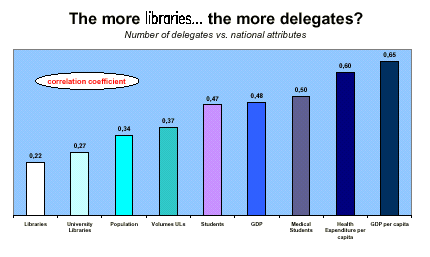
The number of university libraries, the population and the volumes of each country's university
libraries showed also a somewhat low correlation to the number of delegates.
Higher correlations with values from 0,47 to 0,50 derived from the number
of students, the GDP, and the number of medical students. The GDPcap and
the HEcap correlated best with the number of delegates from each country.
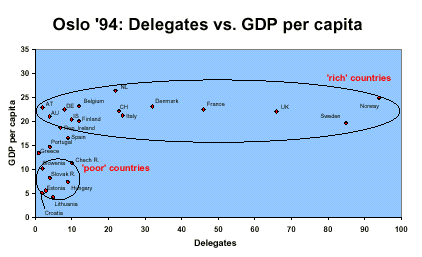 In the diagram above the relation between the number of delegates and GDPcap were shown for the 5th EAHIL conference in Oslo. There were quite different attendance patterns for the "poor" and "rich" countries. The poorer countries were closer together, no one send more than 10 delegates. The richer ones, on the other hand, were not that much uniform. Their attendance figures varied widely. 2. Conference characteristics Beside the country characteristics regarding wealth and health there was yet another attribute which most obviously seems to influence attendance rates: the distance the delegates had to travel. And indeed, the travel distance was negative correlated with the number of delegates. The diagram below shows the correlation for each conference. Only the London delegates showed a somewhat lower correlation - a hint for lower travel hindrances, travel grants or an attractive conference?
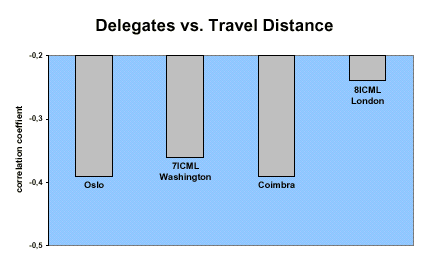
3. EAHIL Similiar to the delegates, the number of the EAHIL members could also be correlated versus the characteristics of their respective countries. The resulting correlation pattern (see below) is quite similiar to that of the conferences. The most obvious difference is the lower correlation between EAHIL members and population size. Again, the closest correlation was versus GDPcap (0,66) and HEcap (0,68).
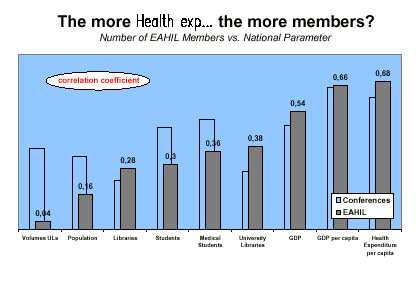 If the number
of EAHIL members is normalized with the health expenditure per capita of
the respective country, the number of EAHIL members each country should
have (according to their HEcap) could be estimated. Conclusions They are some stronge correlations between country attributes and number of delegates of EAHIL and ICML conferences. The correlations could possibly be summarized as: "The wealthier a country the more delegates it sends to international conferences." But this is obviously not the whole truth, as the correlations are not reaching 1.0. And there is the fact that some countries with a low GDPcap were sending more delegates than others with a high GDPcap. And I has to ask why there were major differences within the rich countries? Obviously, there exists another factor which is responsible for that phenomenon. This factor could be either a missed economical or educational quantity or an national attribute not found in statistical yearbooks. Of course, there are differences in mentality, but I promised to do not discuss them here (although it would have been lovely to quarrel about aphorisms like that one from an sorely afflicted EAHIL representative "It's famously difficult to get Germans to conferences" ;-) At the end I would like to suggest that at first these hidden attributes determine if someone wants to participate at a conference or not. Not until then the wealth of a country influences if that wish comes true. Or to conclude with an famous aphorisms: "Wealth without wishing is not sufficient for one to come." You may find
the fulltext of this paper with graphics at: http://medweb.uni-muenster.de/~obsto/text/alghero/poster.pdf
References/Sources - Hans-Christoph
HOBOHM "Information und weltweite Kooperation ohne deutsche Beteiligung
- Bericht zum IFLA Kongress in Jerusalem, August 2000" Nachrichten für
dokumentation 51 (2000) 489-491
|
|
|
|
|
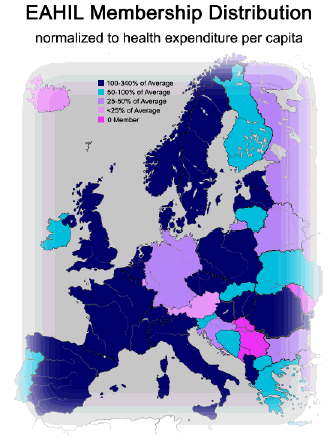 In the map the countries are colored according to their ratio versus the average.
In the map the countries are colored according to their ratio versus the average.